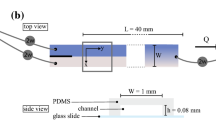Abstract
This paper presents a complete analysis of the theory of an instrument to measure the diffusion coefficients in liquid mixtures based upon the phenomenon of Taylor dispersion. The analysis demonstrates that it is possible to design an instrument that operates very nearly in accordance with the simplest mathematical description of the dispersion of a solute pulse in a fluid in laminar flow within a straight, circular cross-section tube. The small departures of a practical instrument from the ideal are evaluated as corrections by means of a general perturbation treatment that allows them to be examined one at a time. The corrections considered include the effects of the finite volume of the injection pulse, the finite volume of the concentration monitor, the coiling of the tube, and the nonuniformity and noncircularity of the cross section, as well as the variation of the fluid properties with composition. All the equations necessary for the design of an instrument of this type, and for the evaluation of experimental data free from significant systematic errors, are presented.
Similar content being viewed by others
References
R. F. Treybal, Mass Transfer Operations, 2nd ed. (McGraw-Hill, New York, 1968).
B. J. Alder, D. M. Gass, and T. E. Wainwright, J. Chem. Phys. 53:3813 (1970).
E. R. Pike, Photon Correlation and Light Beating Spectroscopy, H. Z. Cummins and E. R. Pike, eds., NATO Advanced Study Institute Series (Plenum, London, 1974), p. 5.
H. J. V. Tyrrell and P. J. Watkiss, Ann. Rep. Chem. Soc., A, 35 (1976).
C. Durou, C. Moutou, and J. Makenc, J. Chim. Phys. 71:2171 (1974).
G. I. Taylor, Proc. Roy. Soc. A219:186 (1953).
A. C. Ouano, Ind. Eng. Chem. Fundam. 11:268 (1972).
K. C. Pratt and W. A. Wakeham, Proc. Roy. Soc. A336:393 (1974).
E. Grushka and V. R. Maynard, J. Phys. Chem. 77:1437 (1973).
K. C. Pratt, D. H. Slater, and W. A. Wakeham, Chem. Eng. Sci. 28:1901 (1973).
H. Komiyama and J. M. Smith, J. Chem. Eng. Data 19:384 (1974).
V. Hancil, V. Rod, and M. Rosenbaum, Chem. Eng. Commun. 3:155 (1979).
R. Aris, Proc. Roy. Soc. A235:67 (1956).
K. C. Pratt and W. A. Wakeham, Proc. Roy Soc. A342:401 (1975).
O. Levenspiel and W. K. Smith, Chem. Eng. Sci. 6:227 (1957).
T. Yano and T. Aratani, Seigyo Kogaku 12:18 (1968).
C. Y. Wen and L. T. Fan, Models for Flow Systems and Chemical Reactors (Marcel Dekker, New York, 1975).
D. J. McConalogue, Proc. Roy. Soc. A315:99 (1970).
M. E. Erdogan and P. C. Chatwin, J. Fluid Mech. 29:465 (1967).
R. J. Nunge, T. S. Lin, and W. N. Gill, J. Fluid Mech. 51:363 (1972).
L. A. M. Janssen, Chem. Eng. Sci. 31:215 (1976).
W. R. Dean, Phil. Mag. 5:673 (1928).
H. C. Topakoglu, J. Math. Mech. 16:1321 (1969).
H. Schlichting, Boundary Layer Theory, 6th ed. (McGraw-Hill, New York, 1968), Chapter VI.
E. Th. Van der Laan, Chem. Eng. Sci. 7:187 (1958).
M. R. Hopkins, Proc. Phys. Soc. 50:703 (1938).
N. G. Barton, J. Fluid Mech. 74:81 (1976).
N. G. Barton, J. Fluid Mech. 74:91 (1976).
R. Smith, J. Fluid Mech. 88:323 (1978).
W. A. Wakeham, Discuss. Farad. Soc. 15 (1980).
Author information
Authors and Affiliations
Rights and permissions
About this article
Cite this article
Alizadeh, A., Nieto de Castro, C.A. & Wakeham, W.A. The theory of the Taylor dispersion technique for liquid diffusivity measurements. Int J Thermophys 1, 243–284 (1980). https://doi.org/10.1007/BF00517126
Received:
Issue Date:
DOI: https://doi.org/10.1007/BF00517126




